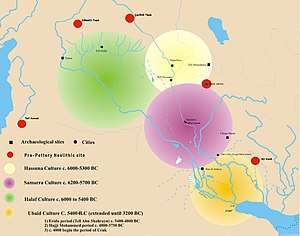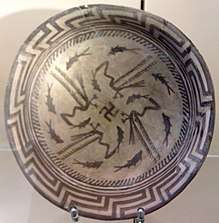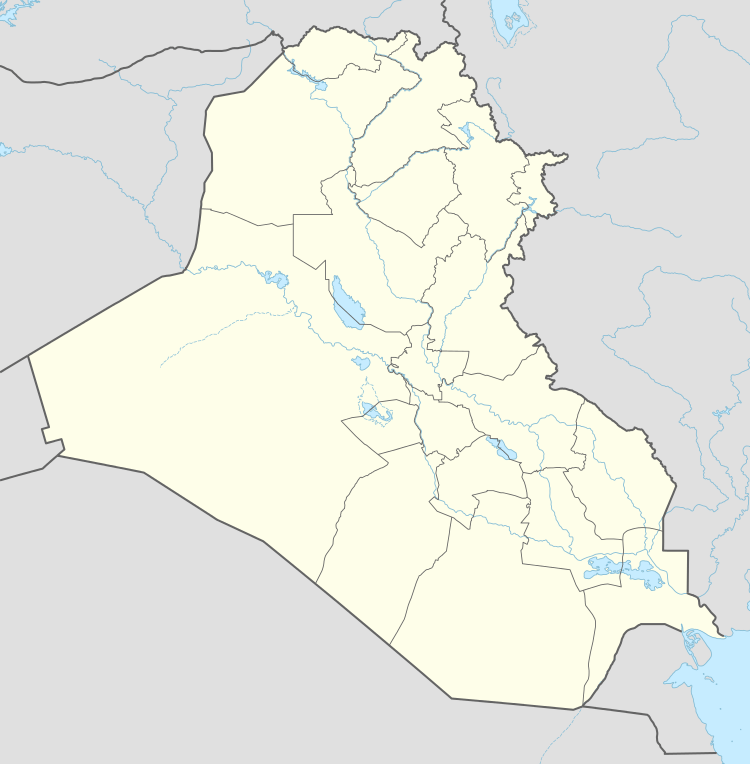Samarra culture
The Samarra culture is a Chalcolithic archaeological culture in northern Mesopotamia that is roughly dated to 5500–4800 BCE. It partially overlaps with Hassuna and early Ubaid. Samarran material culture was first recognized during excavations by German Archaeologist Ernst Herzfeld at the site of Samarra. Other sites where Samarran material has been found include Tell Shemshara, Tell es-Sawwan and Yarim Tepe.[1]
 | |
| Geographical range | Mesopotamia |
|---|---|
| Period | Neolithic |
| Dates | c. 5500 – c. 4800 BCE |
| Type site | Samarra |
| Major sites | Tell Shemshara, Tell es-Sawwan |
| Preceded by | Pre-Pottery Neolithic B, Halaf culture, Hassuna culture, Halaf-Ubaid Transitional period |
| Followed by | Ubaid period |
At Tell es-Sawwan, evidence of irrigation—including flax—establishes the presence of a prosperous settled culture with a highly organized social structure. The culture is primarily known for its finely made pottery decorated with stylized animals, including birds, and geometric designs on dark backgrounds. This widely exported type of pottery, one of the first widespread, relatively uniform pottery styles in the Ancient Near East, was first recognized at Samarra. The Samarran Culture was the precursor to the Mesopotamian culture of the Ubaid period. At Tell Sabi Abyad and other Late Neolithic sites in Syria, scholars adopt increasingly vague terms such as Samarra "influenced", Samarra-"related" or even Samarra "impulses", largely because we do not understand the relationships with the traditional Samarra heartlands. The term may be extended to include sites in Syria such as Tell Chagar Bazar, Tell Boueid II, Tell Sabi Abyad or Tell Halula, where similar pottery is currently being Fig. 1 : Principal sites mentioned in the text. excavated in Pre-Halaf to Early Halaf Transitional contexts
Samarra ware
The ceramic of this culture is named Samarra ware.
 Samarra period fine ware, c. 6200-5700 BC
Samarra period fine ware, c. 6200-5700 BC Female figurine found in the Tell es Sawwan (middle Tigris, near Samarra), level 1, ca. 6000 BC.
Female figurine found in the Tell es Sawwan (middle Tigris, near Samarra), level 1, ca. 6000 BC.- Fragment of Samarra pottery.
 Samarra bowl, circa 4000 BC
Samarra bowl, circa 4000 BC
Chronological context
See also
- Desert Kites
- Hassuna culture
- History of Mesopotamia
References
- Blackham, Mark (1996). "Further Investigations as to the Relationship of Samarran and Ubaid Ceramic Assemblages". Iraq. 58: 1–15. doi:10.1017/S0021088900003144. JSTOR 4200416.
- Liverani, Mario (2013). The Ancient Near East: History, Society and Economy. Routledge. p. 13, Table 1.1 "Chronology of the Ancient Near East". ISBN 9781134750917.
- Shukurov, Anvar; Sarson, Graeme R.; Gangal, Kavita (7 May 2014). "The Near-Eastern Roots of the Neolithic in South Asia". PLOS ONE. 9 (5): e95714. Bibcode:2014PLoSO...995714G. doi:10.1371/journal.pone.0095714. ISSN 1932-6203. PMC 4012948. PMID 24806472.
- Bar-Yosef, Ofer; Arpin, Trina; Pan, Yan; Cohen, David; Goldberg, Paul; Zhang, Chi; Wu, Xiaohong (29 June 2012). "Early Pottery at 20,000 Years Ago in Xianrendong Cave, China". Science. 336 (6089): 1696–1700. Bibcode:2012Sci...336.1696W. doi:10.1126/science.1218643. ISSN 0036-8075. PMID 22745428.
- Thorpe, I. J. (2003). The Origins of Agriculture in Europe. Routledge. p. 14. ISBN 9781134620104.
- Price, T. Douglas (2000). Europe's First Farmers. Cambridge University Press. p. 3. ISBN 9780521665728.
- Jr, William H. Stiebing; Helft, Susan N. (2017). Ancient Near Eastern History and Culture. Routledge. p. 25. ISBN 9781134880836.
- NIEUWENHUYSE, Olivier; JACOBS, Loe; VAN AS, Bram; BROEKMANS, Tom; ADRIAENS, A. Mieke (2001). "Making Samarra Fine Ware - Technological Observations on Ceramics from Tell Baghouz (Syria)". Paléorient. 27 (1): 147–165. doi:10.3406/paleo.2001.4726. JSTOR 41496601.

